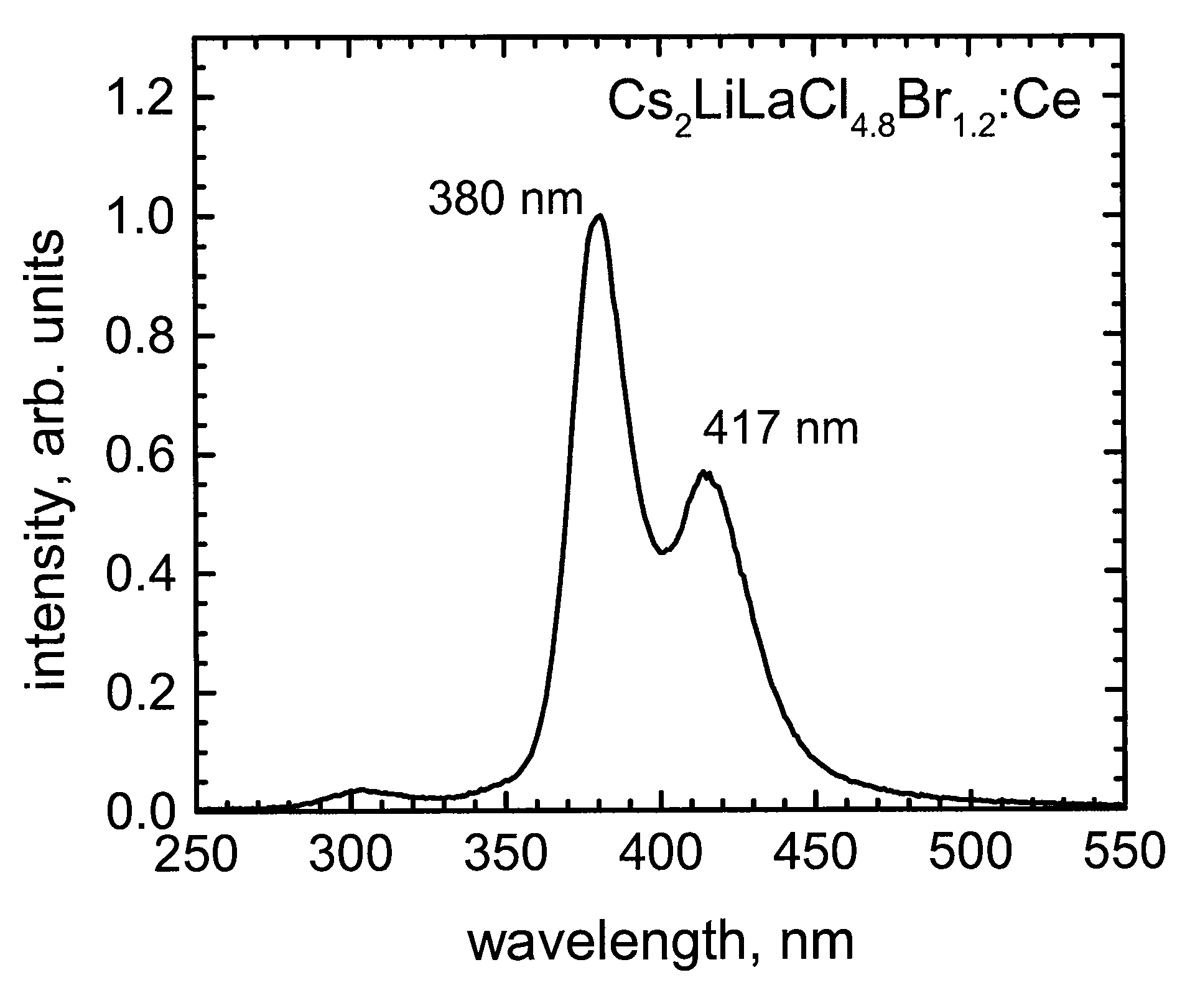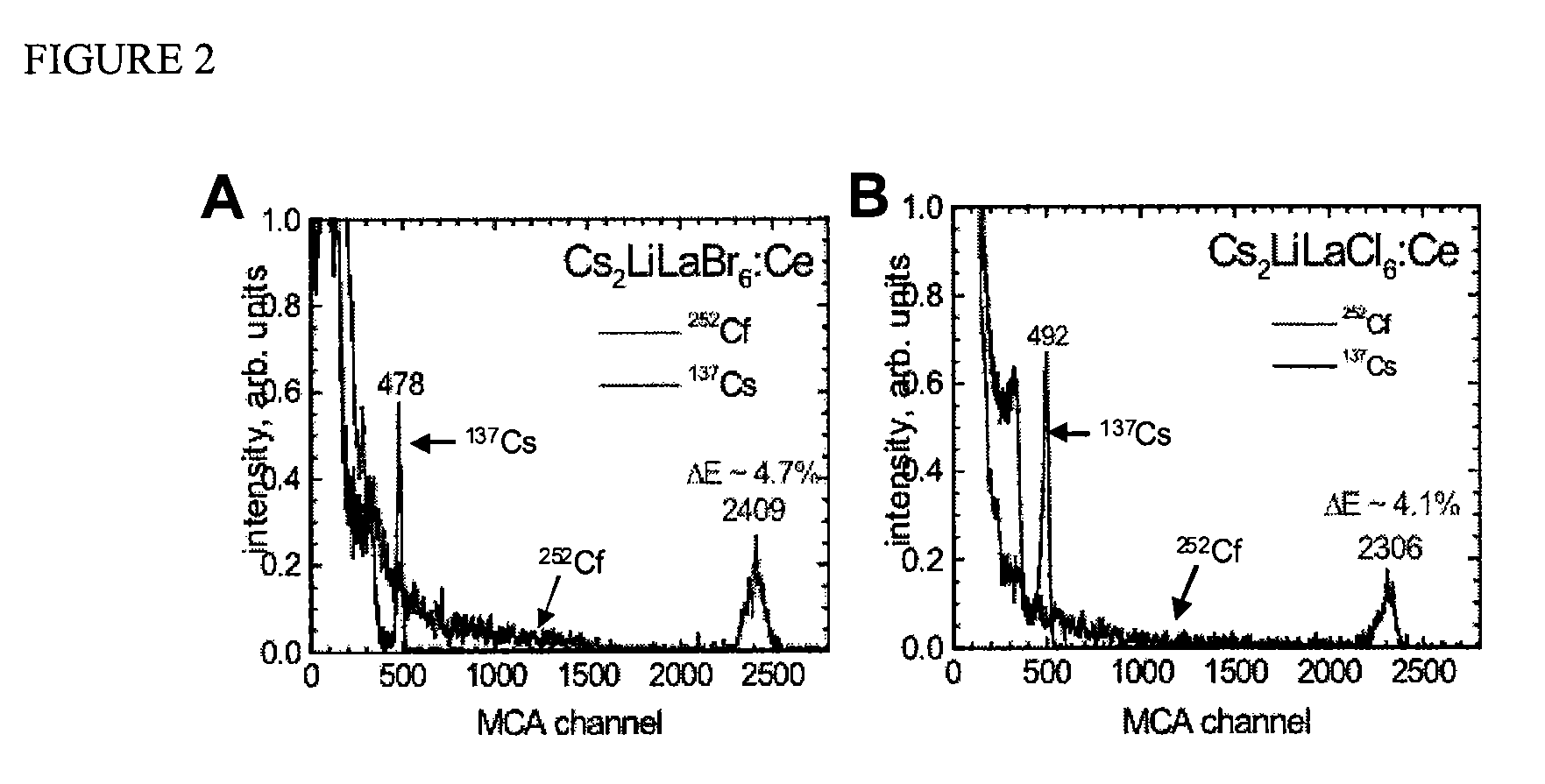[0035]
Scintillator compositions can include a single
quaternary compound selected from those described herein or a mixture thereof. Compositions can, e.g., include mixed
halide compositions with at least two different CsLiLa halide compounds. Thus, one
advantage of the present invention includes the ability to select or customize a particular mixed composition ratio or formulation that may be selected at least partially based on intended use of the scintillator composition and / or desired properties or scintillation / performance characteristics. For example, a particular mixed
quaternary compound composition (e.g., mixed CsLiLa halide composition) formulation may be selected based on one or more of a variety of factors, such as desired
stopping power (e.g., at least partially as a function of
atomic number),
neutron response, bandgap levels tuning / optimization for Ce emission and light output, pulse shape discrimination, gamma-
ray sensitivity, and the like.
[0036]In one embodiment, a mixed halide scintillator composition can include, for example, a mixture of two or more of Cs2LiLaF6, Cs2LiLaCl6, Cs2LiLaBr6, and Cs2LiLaI6. As noted above, combinations are not limited to any specific halide ratio / formulation for mixed halide scintillator compositions. FIG. 8 shows an
emission spectrum of an exemplary mixed halide composition in which Cl and Br are present at a ratio of 4.8:1.2.
[0037]The scintillators of the invention are particularly useful, for example, for
spectroscopy detection of energetic photons (e.g., X-rays, gamma-rays), as well as for
neutron emission detection. Notable characteristics for the scintillation compositions of the invention include surprisingly robust light output, high gamma-
ray and neutron stopping efficiency (attenuation), fast response, and good non-proportionality. Furthermore, the scintillator compositions can be efficiently and economically produced. Thus, detectors having a
quaternary compound scintillator that is described in the present invention are useful in a wide variety of applications, including without limitation nuclear and
high energy physics research,
medical imaging,
diffraction, non-
destructive testing, nuclear treaty
verification and safeguards, and
geological exploration.
[0038]The scintillator composition of the present invention can optionally include a “
dopant”. Dopants can affect certain properties, such as physical properties (e.g.,
brittleness, etc.) as well as scintillation properties (e.g.,
luminescence, etc.) of the scintillator composition. The
dopant can include, for example,
cerium (Ce),
praseodymium (Pr),
lutetium (Lu),
lanthanum (La),
europium (Eu),
samarium (Sm),
strontium (Sr),
thallium (Tl),
chlorine (Cl),
fluorine (F),
iodine (I), and mixtures of any of the dopants. The amount of dopant present will depend on various factors, such as the application for which the scintillator composition is being used; the desired scintillation properties (e.g., emission properties, timing resolution, etc.); and the type of detection device into which the scintillator is being incorporated. For example, the dopant is typically employed at a level in the range of about 0.1% to about 20%, by
molar weight. In certain embodiments, the amount of dopant is in the range of about 0.1% to about 100%, or about 0.1% to about 5.0%, or about 5.0% to about 20%, by
molar weight.
[0039]The scintillator composition of the invention may be prepared in several different forms. In some embodiments, the composition is in a crystalline form (e.g., monocrystalline).
Scintillation crystals, such as monocrystalline scintillators, have a greater tendency for transparency than other forms. Scintillators in crystalline form (e.g.,
scintillation crystals) are often useful for high-energy
radiation detectors, e.g., those used for gamma-ray or X-ray detection. However, the composition can include other forms as well, and the selected form may depend, in part, on the intended end use of the scintillator. For example, a scintillator can be in a
powder form. It can also be prepared in the form of a
ceramic or polycrystalline
ceramic. Other forms of scintillation compositions will be recognized and can include, for example, glasses, deposits, vapor deposited films, microcolumnar, or other forms suitable for radiation detection as described herein. It should also be understood that a scintillator composition might contain small amounts of impurities. Also, minor amounts of other materials may be purposefully included in the scintillator compositions to affect the properties of the scintillator compositions.
[0040]Methods for making
crystal materials can include those methods described herein and may further include other techniques. Typically, the appropriate reactants are melted at a temperature sufficient to form a congruent, molten composition. The
melting temperature will depend on the identity of the reactants themselves (see, e.g., melting points of reactants), but is usually in the range of about 300° C. to about 1350° C. Non-limiting examples of the
crystal-growing methods can include certain techniques of the Bridgman-Stockbarger methods; the Czochralski methods, the zone-melting methods (or “floating zone” method), the
vertical gradient freeze (VGF) methods, and the
temperature gradient methods. See, e.g.,
 Login to View More
Login to View More  Login to View More
Login to View More 


